Economics and Economic Policies Assignment: Growth, Trade, Exchange
VerifiedAdded on 2020/03/23
|12
|2743
|197
Homework Assignment
AI Summary
This economics assignment analyzes the economic policies and performance of New Zealand. It addresses government objectives such as economic growth and full employment, exploring related tradeoffs. The assignment delves into fiscal policy, examining its instruments and impact on the labor market. It also assesses the advantages and disadvantages of free trade, the balance of payments, and the current account balance, including the effects of various economic events. Furthermore, the assignment investigates foreign exchange dynamics, explaining the impact of currency appreciation and depreciation on exporters, importers, and net exports, as well as the relationship between foreign exchange and monetary policy. The analysis draws on economic concepts and provides calculations related to the current account balance.
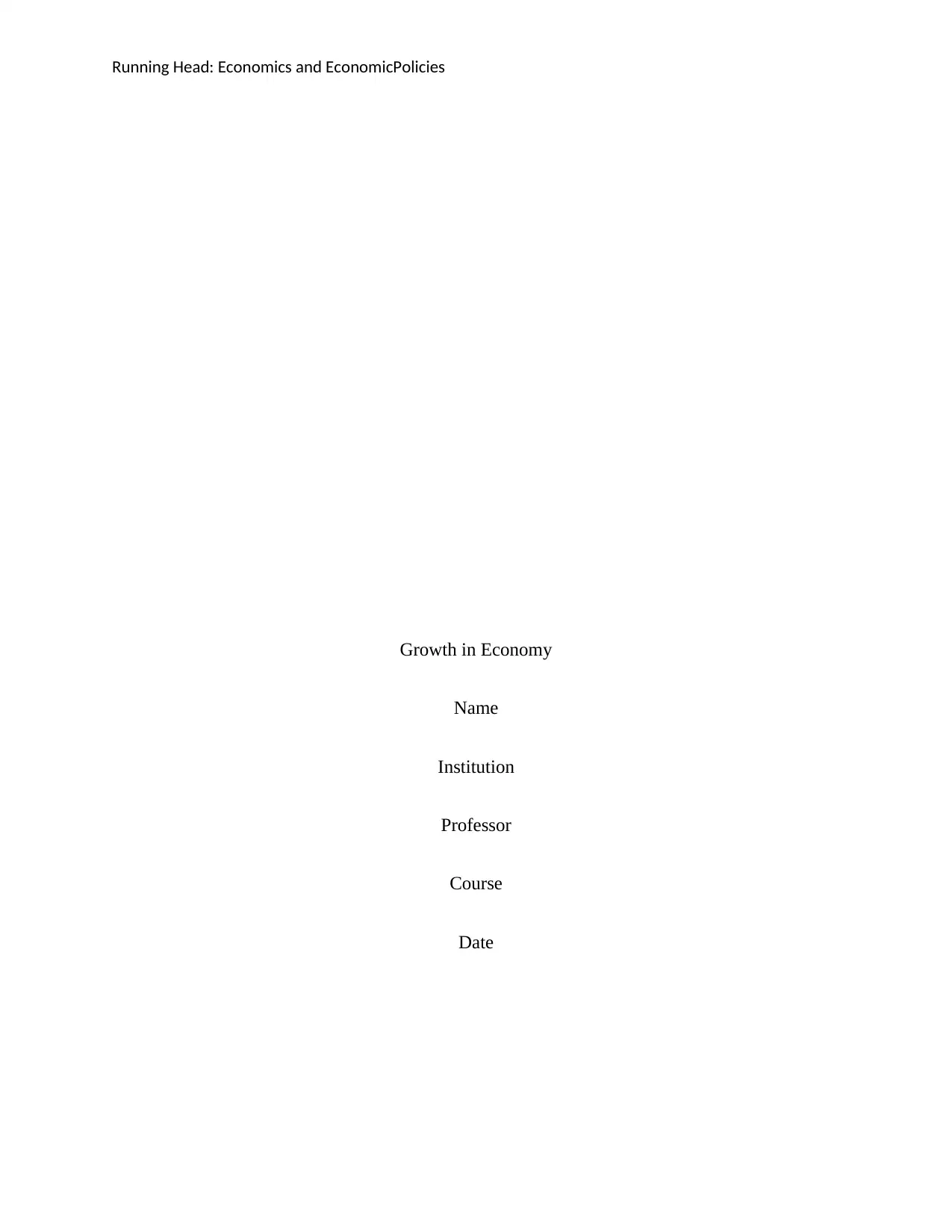
Running Head: Economics and EconomicPolicies
Growth in Economy
Name
Institution
Professor
Course
Date
Growth in Economy
Name
Institution
Professor
Course
Date
Paraphrase This Document
Need a fresh take? Get an instant paraphrase of this document with our AI Paraphraser
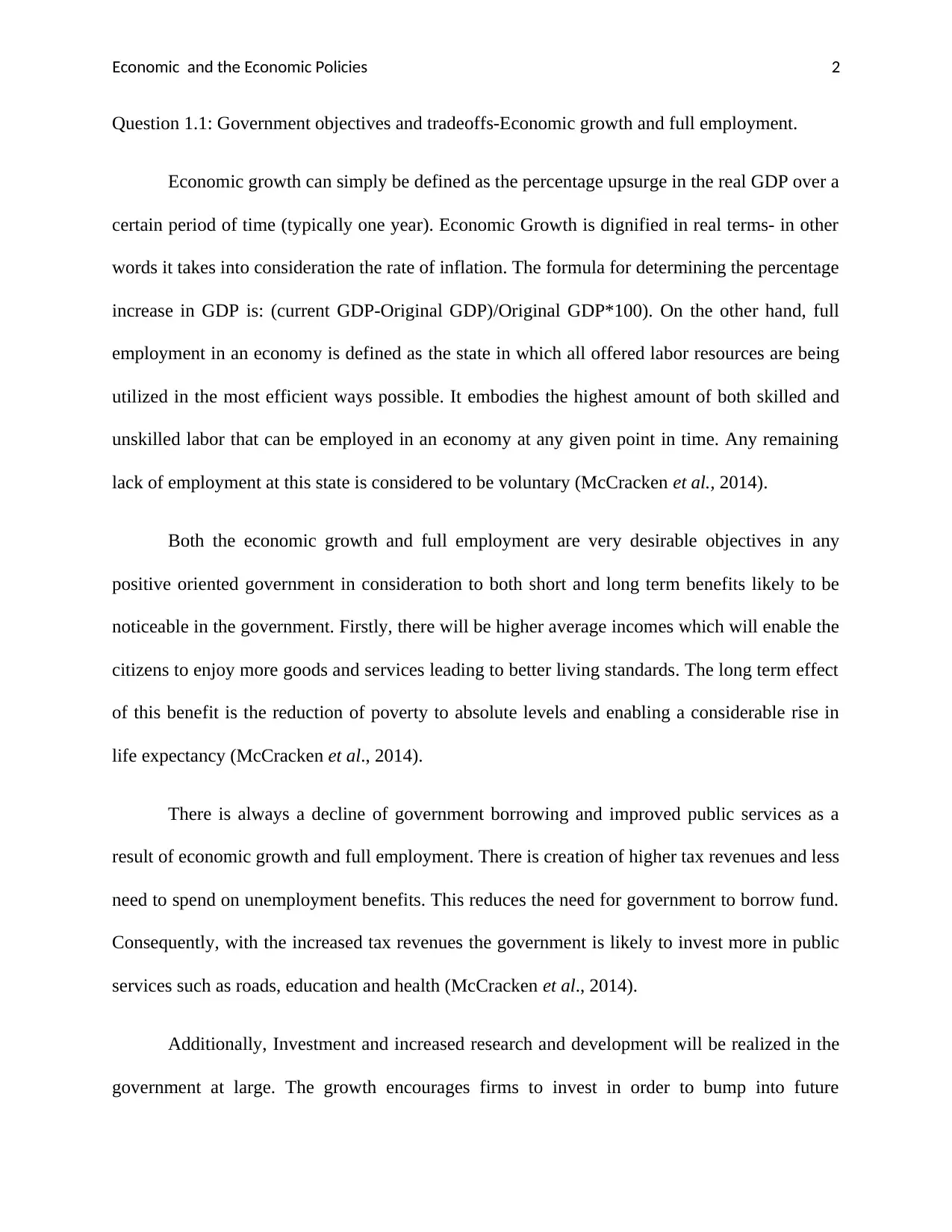
Economic and the Economic Policies 2
Question 1.1: Government objectives and tradeoffs-Economic growth and full employment.
Economic growth can simply be defined as the percentage upsurge in the real GDP over a
certain period of time (typically one year). Economic Growth is dignified in real terms- in other
words it takes into consideration the rate of inflation. The formula for determining the percentage
increase in GDP is: (current GDP-Original GDP)/Original GDP*100). On the other hand, full
employment in an economy is defined as the state in which all offered labor resources are being
utilized in the most efficient ways possible. It embodies the highest amount of both skilled and
unskilled labor that can be employed in an economy at any given point in time. Any remaining
lack of employment at this state is considered to be voluntary (McCracken et al., 2014).
Both the economic growth and full employment are very desirable objectives in any
positive oriented government in consideration to both short and long term benefits likely to be
noticeable in the government. Firstly, there will be higher average incomes which will enable the
citizens to enjoy more goods and services leading to better living standards. The long term effect
of this benefit is the reduction of poverty to absolute levels and enabling a considerable rise in
life expectancy (McCracken et al., 2014).
There is always a decline of government borrowing and improved public services as a
result of economic growth and full employment. There is creation of higher tax revenues and less
need to spend on unemployment benefits. This reduces the need for government to borrow fund.
Consequently, with the increased tax revenues the government is likely to invest more in public
services such as roads, education and health (McCracken et al., 2014).
Additionally, Investment and increased research and development will be realized in the
government at large. The growth encourages firms to invest in order to bump into future
Question 1.1: Government objectives and tradeoffs-Economic growth and full employment.
Economic growth can simply be defined as the percentage upsurge in the real GDP over a
certain period of time (typically one year). Economic Growth is dignified in real terms- in other
words it takes into consideration the rate of inflation. The formula for determining the percentage
increase in GDP is: (current GDP-Original GDP)/Original GDP*100). On the other hand, full
employment in an economy is defined as the state in which all offered labor resources are being
utilized in the most efficient ways possible. It embodies the highest amount of both skilled and
unskilled labor that can be employed in an economy at any given point in time. Any remaining
lack of employment at this state is considered to be voluntary (McCracken et al., 2014).
Both the economic growth and full employment are very desirable objectives in any
positive oriented government in consideration to both short and long term benefits likely to be
noticeable in the government. Firstly, there will be higher average incomes which will enable the
citizens to enjoy more goods and services leading to better living standards. The long term effect
of this benefit is the reduction of poverty to absolute levels and enabling a considerable rise in
life expectancy (McCracken et al., 2014).
There is always a decline of government borrowing and improved public services as a
result of economic growth and full employment. There is creation of higher tax revenues and less
need to spend on unemployment benefits. This reduces the need for government to borrow fund.
Consequently, with the increased tax revenues the government is likely to invest more in public
services such as roads, education and health (McCracken et al., 2014).
Additionally, Investment and increased research and development will be realized in the
government at large. The growth encourages firms to invest in order to bump into future
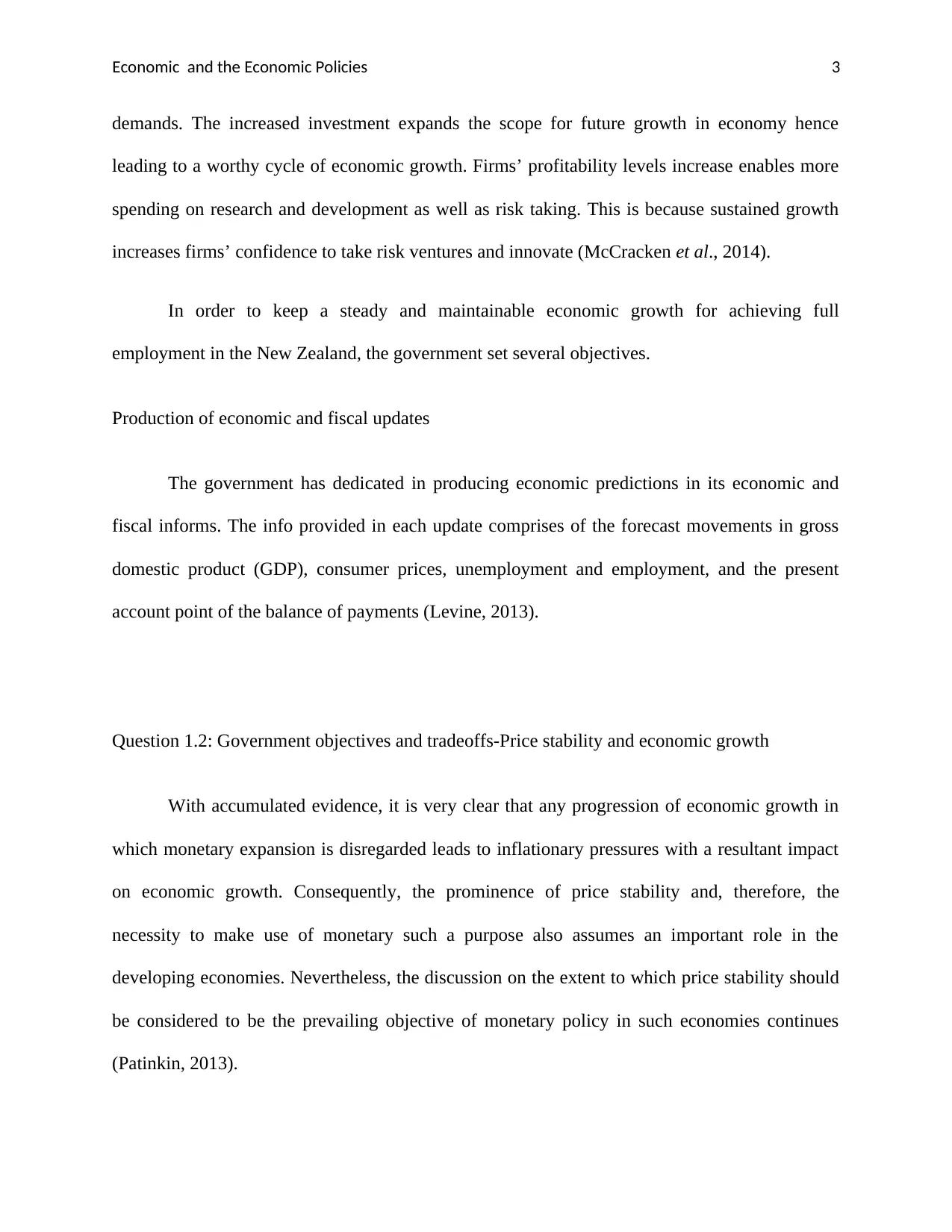
Economic and the Economic Policies 3
demands. The increased investment expands the scope for future growth in economy hence
leading to a worthy cycle of economic growth. Firms’ profitability levels increase enables more
spending on research and development as well as risk taking. This is because sustained growth
increases firms’ confidence to take risk ventures and innovate (McCracken et al., 2014).
In order to keep a steady and maintainable economic growth for achieving full
employment in the New Zealand, the government set several objectives.
Production of economic and fiscal updates
The government has dedicated in producing economic predictions in its economic and
fiscal informs. The info provided in each update comprises of the forecast movements in gross
domestic product (GDP), consumer prices, unemployment and employment, and the present
account point of the balance of payments (Levine, 2013).
Question 1.2: Government objectives and tradeoffs-Price stability and economic growth
With accumulated evidence, it is very clear that any progression of economic growth in
which monetary expansion is disregarded leads to inflationary pressures with a resultant impact
on economic growth. Consequently, the prominence of price stability and, therefore, the
necessity to make use of monetary such a purpose also assumes an important role in the
developing economies. Nevertheless, the discussion on the extent to which price stability should
be considered to be the prevailing objective of monetary policy in such economies continues
(Patinkin, 2013).
demands. The increased investment expands the scope for future growth in economy hence
leading to a worthy cycle of economic growth. Firms’ profitability levels increase enables more
spending on research and development as well as risk taking. This is because sustained growth
increases firms’ confidence to take risk ventures and innovate (McCracken et al., 2014).
In order to keep a steady and maintainable economic growth for achieving full
employment in the New Zealand, the government set several objectives.
Production of economic and fiscal updates
The government has dedicated in producing economic predictions in its economic and
fiscal informs. The info provided in each update comprises of the forecast movements in gross
domestic product (GDP), consumer prices, unemployment and employment, and the present
account point of the balance of payments (Levine, 2013).
Question 1.2: Government objectives and tradeoffs-Price stability and economic growth
With accumulated evidence, it is very clear that any progression of economic growth in
which monetary expansion is disregarded leads to inflationary pressures with a resultant impact
on economic growth. Consequently, the prominence of price stability and, therefore, the
necessity to make use of monetary such a purpose also assumes an important role in the
developing economies. Nevertheless, the discussion on the extent to which price stability should
be considered to be the prevailing objective of monetary policy in such economies continues
(Patinkin, 2013).
⊘ This is a preview!⊘
Do you want full access?
Subscribe today to unlock all pages.

Trusted by 1+ million students worldwide
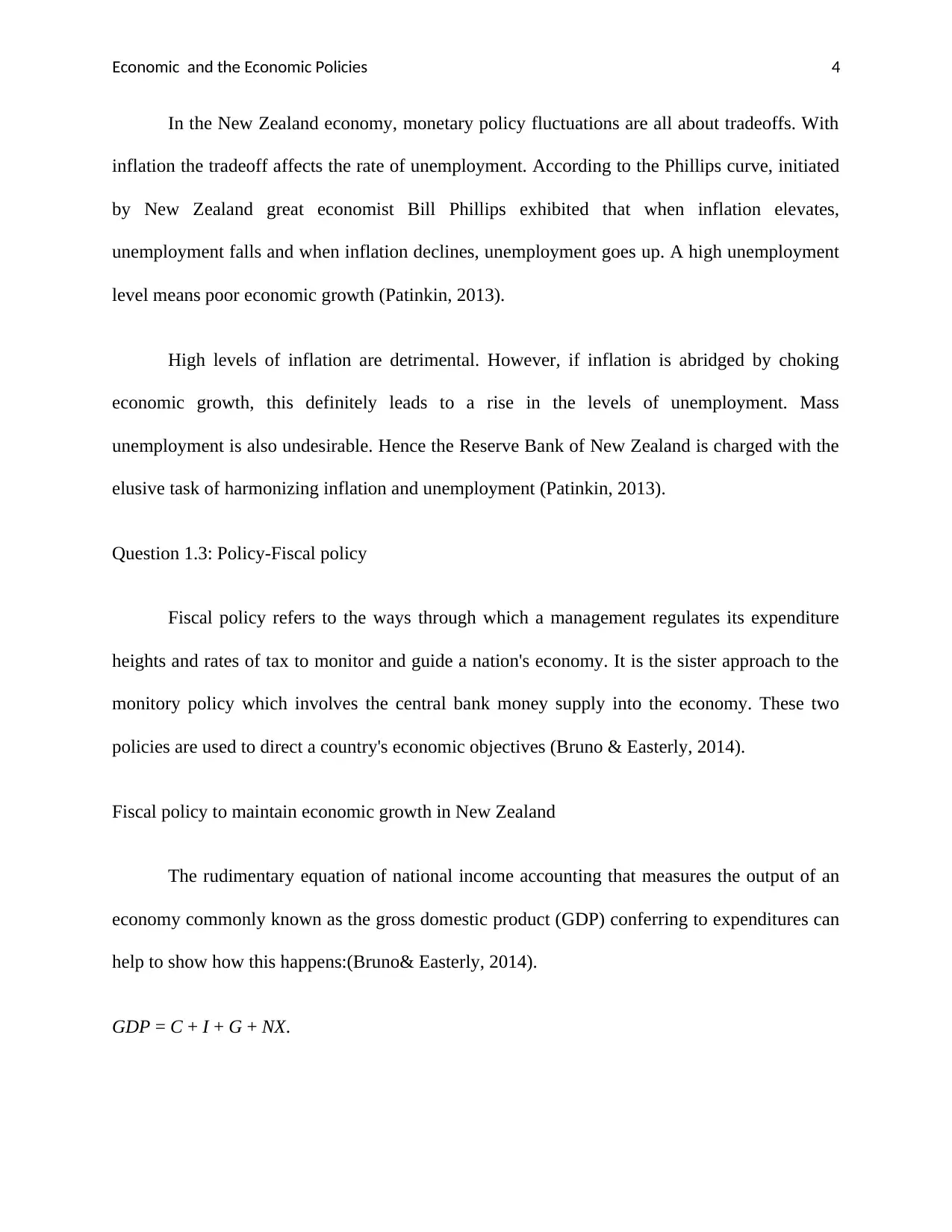
Economic and the Economic Policies 4
In the New Zealand economy, monetary policy fluctuations are all about tradeoffs. With
inflation the tradeoff affects the rate of unemployment. According to the Phillips curve, initiated
by New Zealand great economist Bill Phillips exhibited that when inflation elevates,
unemployment falls and when inflation declines, unemployment goes up. A high unemployment
level means poor economic growth (Patinkin, 2013).
High levels of inflation are detrimental. However, if inflation is abridged by choking
economic growth, this definitely leads to a rise in the levels of unemployment. Mass
unemployment is also undesirable. Hence the Reserve Bank of New Zealand is charged with the
elusive task of harmonizing inflation and unemployment (Patinkin, 2013).
Question 1.3: Policy-Fiscal policy
Fiscal policy refers to the ways through which a management regulates its expenditure
heights and rates of tax to monitor and guide a nation's economy. It is the sister approach to the
monitory policy which involves the central bank money supply into the economy. These two
policies are used to direct a country's economic objectives (Bruno & Easterly, 2014).
Fiscal policy to maintain economic growth in New Zealand
The rudimentary equation of national income accounting that measures the output of an
economy commonly known as the gross domestic product (GDP) conferring to expenditures can
help to show how this happens:(Bruno& Easterly, 2014).
GDP = C + I + G + NX.
In the New Zealand economy, monetary policy fluctuations are all about tradeoffs. With
inflation the tradeoff affects the rate of unemployment. According to the Phillips curve, initiated
by New Zealand great economist Bill Phillips exhibited that when inflation elevates,
unemployment falls and when inflation declines, unemployment goes up. A high unemployment
level means poor economic growth (Patinkin, 2013).
High levels of inflation are detrimental. However, if inflation is abridged by choking
economic growth, this definitely leads to a rise in the levels of unemployment. Mass
unemployment is also undesirable. Hence the Reserve Bank of New Zealand is charged with the
elusive task of harmonizing inflation and unemployment (Patinkin, 2013).
Question 1.3: Policy-Fiscal policy
Fiscal policy refers to the ways through which a management regulates its expenditure
heights and rates of tax to monitor and guide a nation's economy. It is the sister approach to the
monitory policy which involves the central bank money supply into the economy. These two
policies are used to direct a country's economic objectives (Bruno & Easterly, 2014).
Fiscal policy to maintain economic growth in New Zealand
The rudimentary equation of national income accounting that measures the output of an
economy commonly known as the gross domestic product (GDP) conferring to expenditures can
help to show how this happens:(Bruno& Easterly, 2014).
GDP = C + I + G + NX.
Paraphrase This Document
Need a fresh take? Get an instant paraphrase of this document with our AI Paraphraser
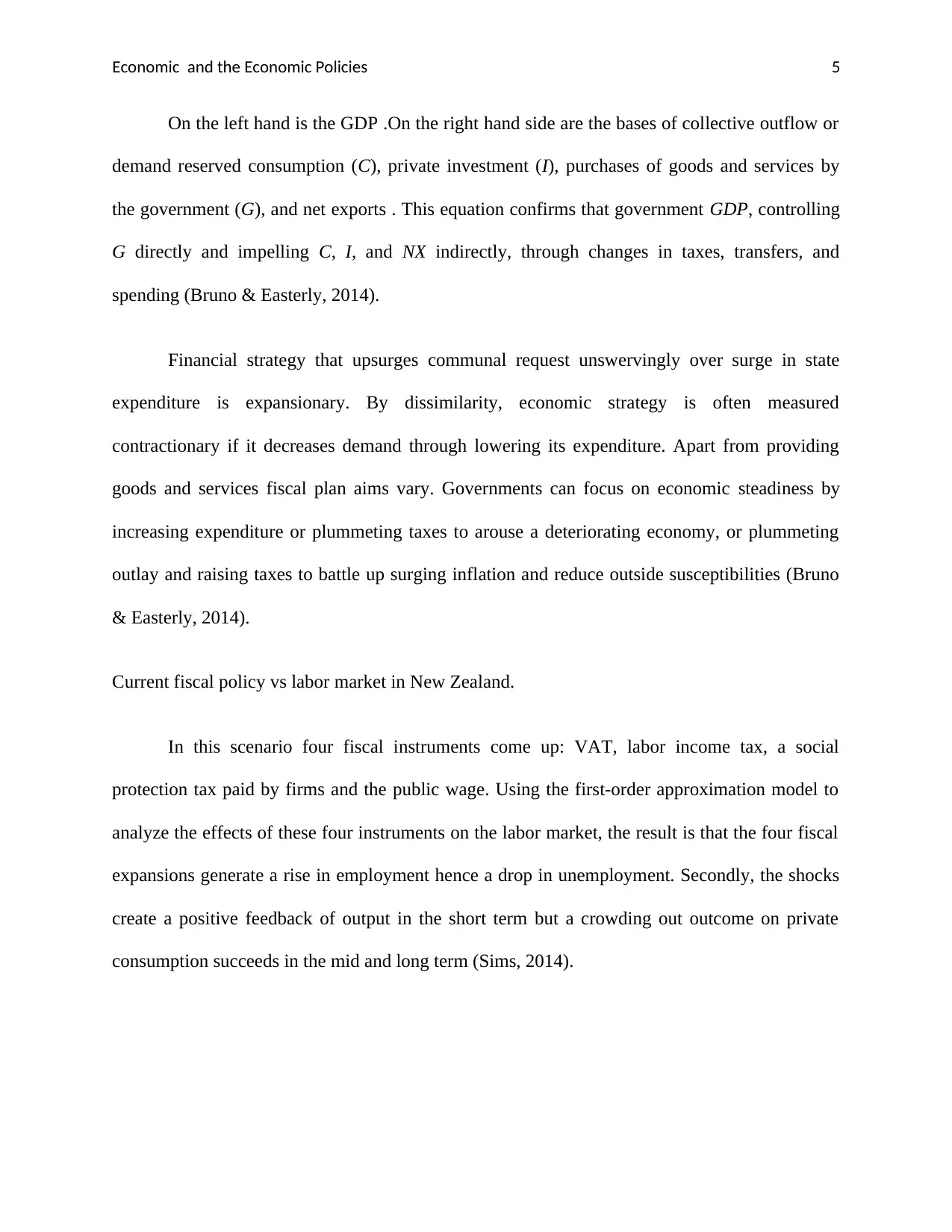
Economic and the Economic Policies 5
On the left hand is the GDP .On the right hand side are the bases of collective outflow or
demand reserved consumption (C), private investment (I), purchases of goods and services by
the government (G), and net exports . This equation confirms that government GDP, controlling
G directly and impelling C, I, and NX indirectly, through changes in taxes, transfers, and
spending (Bruno & Easterly, 2014).
Financial strategy that upsurges communal request unswervingly over surge in state
expenditure is expansionary. By dissimilarity, economic strategy is often measured
contractionary if it decreases demand through lowering its expenditure. Apart from providing
goods and services fiscal plan aims vary. Governments can focus on economic steadiness by
increasing expenditure or plummeting taxes to arouse a deteriorating economy, or plummeting
outlay and raising taxes to battle up surging inflation and reduce outside susceptibilities (Bruno
& Easterly, 2014).
Current fiscal policy vs labor market in New Zealand.
In this scenario four fiscal instruments come up: VAT, labor income tax, a social
protection tax paid by firms and the public wage. Using the first-order approximation model to
analyze the effects of these four instruments on the labor market, the result is that the four fiscal
expansions generate a rise in employment hence a drop in unemployment. Secondly, the shocks
create a positive feedback of output in the short term but a crowding out outcome on private
consumption succeeds in the mid and long term (Sims, 2014).
On the left hand is the GDP .On the right hand side are the bases of collective outflow or
demand reserved consumption (C), private investment (I), purchases of goods and services by
the government (G), and net exports . This equation confirms that government GDP, controlling
G directly and impelling C, I, and NX indirectly, through changes in taxes, transfers, and
spending (Bruno & Easterly, 2014).
Financial strategy that upsurges communal request unswervingly over surge in state
expenditure is expansionary. By dissimilarity, economic strategy is often measured
contractionary if it decreases demand through lowering its expenditure. Apart from providing
goods and services fiscal plan aims vary. Governments can focus on economic steadiness by
increasing expenditure or plummeting taxes to arouse a deteriorating economy, or plummeting
outlay and raising taxes to battle up surging inflation and reduce outside susceptibilities (Bruno
& Easterly, 2014).
Current fiscal policy vs labor market in New Zealand.
In this scenario four fiscal instruments come up: VAT, labor income tax, a social
protection tax paid by firms and the public wage. Using the first-order approximation model to
analyze the effects of these four instruments on the labor market, the result is that the four fiscal
expansions generate a rise in employment hence a drop in unemployment. Secondly, the shocks
create a positive feedback of output in the short term but a crowding out outcome on private
consumption succeeds in the mid and long term (Sims, 2014).
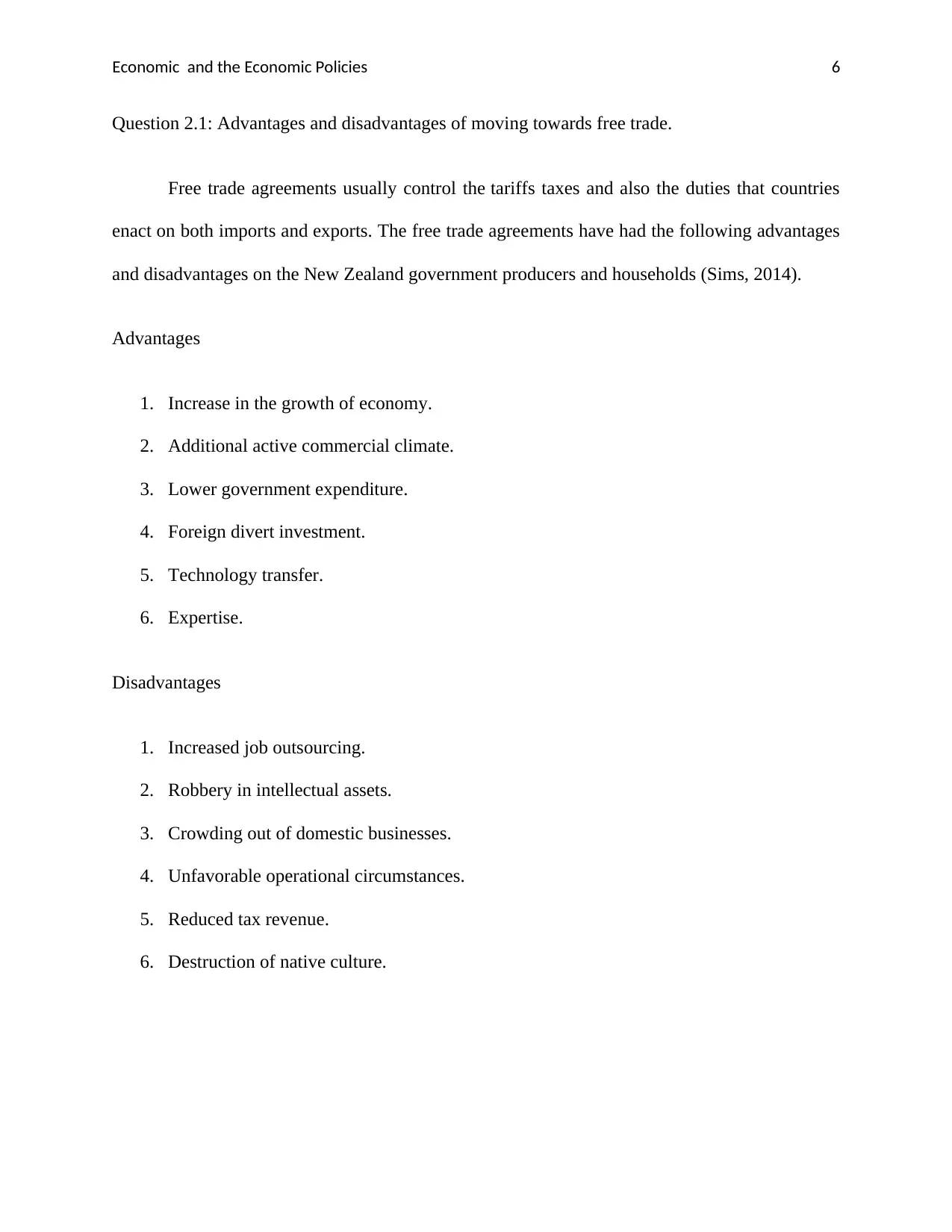
Economic and the Economic Policies 6
Question 2.1: Advantages and disadvantages of moving towards free trade.
Free trade agreements usually control the tariffs taxes and also the duties that countries
enact on both imports and exports. The free trade agreements have had the following advantages
and disadvantages on the New Zealand government producers and households (Sims, 2014).
Advantages
1. Increase in the growth of economy.
2. Additional active commercial climate.
3. Lower government expenditure.
4. Foreign divert investment.
5. Technology transfer.
6. Expertise.
Disadvantages
1. Increased job outsourcing.
2. Robbery in intellectual assets.
3. Crowding out of domestic businesses.
4. Unfavorable operational circumstances.
5. Reduced tax revenue.
6. Destruction of native culture.
Question 2.1: Advantages and disadvantages of moving towards free trade.
Free trade agreements usually control the tariffs taxes and also the duties that countries
enact on both imports and exports. The free trade agreements have had the following advantages
and disadvantages on the New Zealand government producers and households (Sims, 2014).
Advantages
1. Increase in the growth of economy.
2. Additional active commercial climate.
3. Lower government expenditure.
4. Foreign divert investment.
5. Technology transfer.
6. Expertise.
Disadvantages
1. Increased job outsourcing.
2. Robbery in intellectual assets.
3. Crowding out of domestic businesses.
4. Unfavorable operational circumstances.
5. Reduced tax revenue.
6. Destruction of native culture.
⊘ This is a preview!⊘
Do you want full access?
Subscribe today to unlock all pages.

Trusted by 1+ million students worldwide
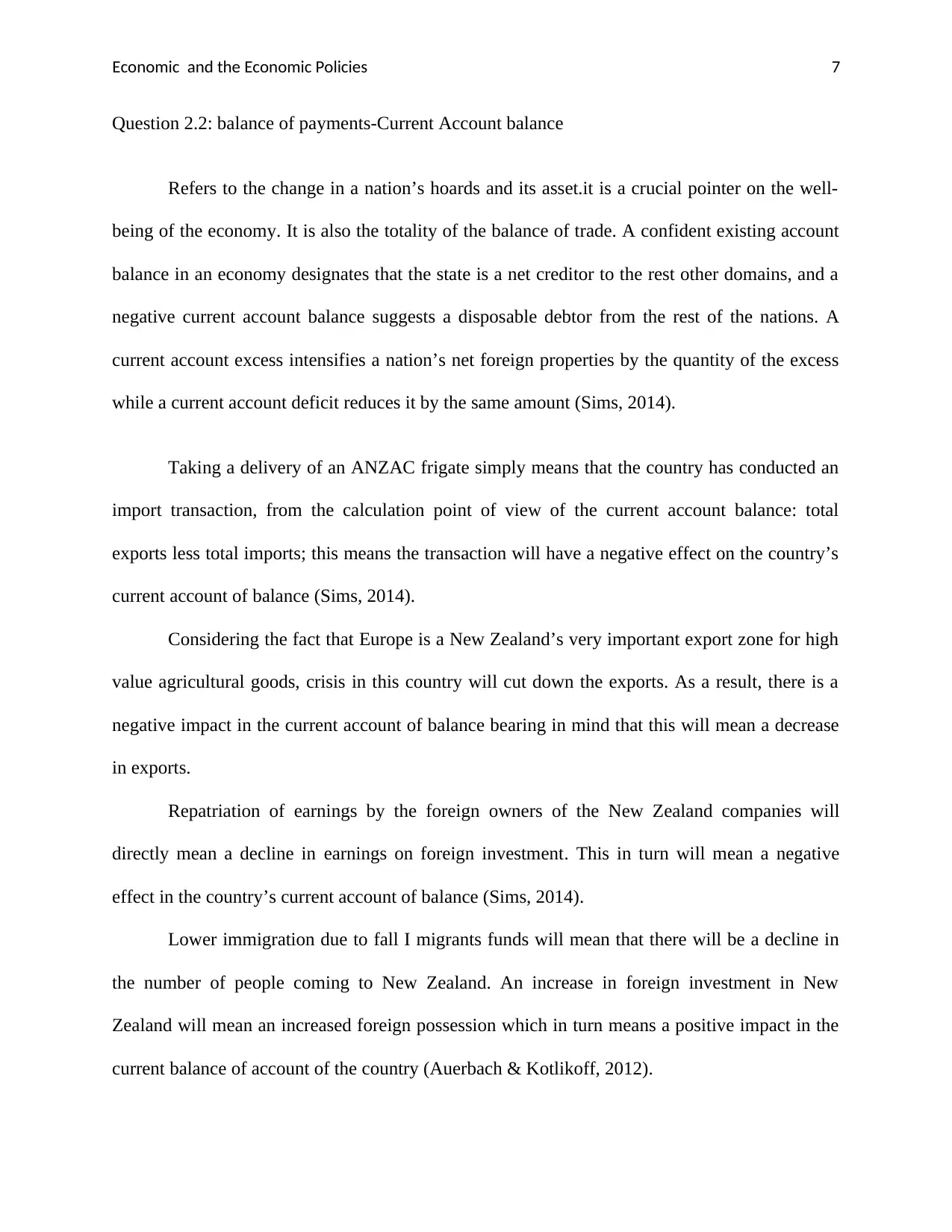
Economic and the Economic Policies 7
Question 2.2: balance of payments-Current Account balance
Refers to the change in a nation’s hoards and its asset.it is a crucial pointer on the well-
being of the economy. It is also the totality of the balance of trade. A confident existing account
balance in an economy designates that the state is a net creditor to the rest other domains, and a
negative current account balance suggests a disposable debtor from the rest of the nations. A
current account excess intensifies a nation’s net foreign properties by the quantity of the excess
while a current account deficit reduces it by the same amount (Sims, 2014).
Taking a delivery of an ANZAC frigate simply means that the country has conducted an
import transaction, from the calculation point of view of the current account balance: total
exports less total imports; this means the transaction will have a negative effect on the country’s
current account of balance (Sims, 2014).
Considering the fact that Europe is a New Zealand’s very important export zone for high
value agricultural goods, crisis in this country will cut down the exports. As a result, there is a
negative impact in the current account of balance bearing in mind that this will mean a decrease
in exports.
Repatriation of earnings by the foreign owners of the New Zealand companies will
directly mean a decline in earnings on foreign investment. This in turn will mean a negative
effect in the country’s current account of balance (Sims, 2014).
Lower immigration due to fall I migrants funds will mean that there will be a decline in
the number of people coming to New Zealand. An increase in foreign investment in New
Zealand will mean an increased foreign possession which in turn means a positive impact in the
current balance of account of the country (Auerbach & Kotlikoff, 2012).
Question 2.2: balance of payments-Current Account balance
Refers to the change in a nation’s hoards and its asset.it is a crucial pointer on the well-
being of the economy. It is also the totality of the balance of trade. A confident existing account
balance in an economy designates that the state is a net creditor to the rest other domains, and a
negative current account balance suggests a disposable debtor from the rest of the nations. A
current account excess intensifies a nation’s net foreign properties by the quantity of the excess
while a current account deficit reduces it by the same amount (Sims, 2014).
Taking a delivery of an ANZAC frigate simply means that the country has conducted an
import transaction, from the calculation point of view of the current account balance: total
exports less total imports; this means the transaction will have a negative effect on the country’s
current account of balance (Sims, 2014).
Considering the fact that Europe is a New Zealand’s very important export zone for high
value agricultural goods, crisis in this country will cut down the exports. As a result, there is a
negative impact in the current account of balance bearing in mind that this will mean a decrease
in exports.
Repatriation of earnings by the foreign owners of the New Zealand companies will
directly mean a decline in earnings on foreign investment. This in turn will mean a negative
effect in the country’s current account of balance (Sims, 2014).
Lower immigration due to fall I migrants funds will mean that there will be a decline in
the number of people coming to New Zealand. An increase in foreign investment in New
Zealand will mean an increased foreign possession which in turn means a positive impact in the
current balance of account of the country (Auerbach & Kotlikoff, 2012).
Paraphrase This Document
Need a fresh take? Get an instant paraphrase of this document with our AI Paraphraser
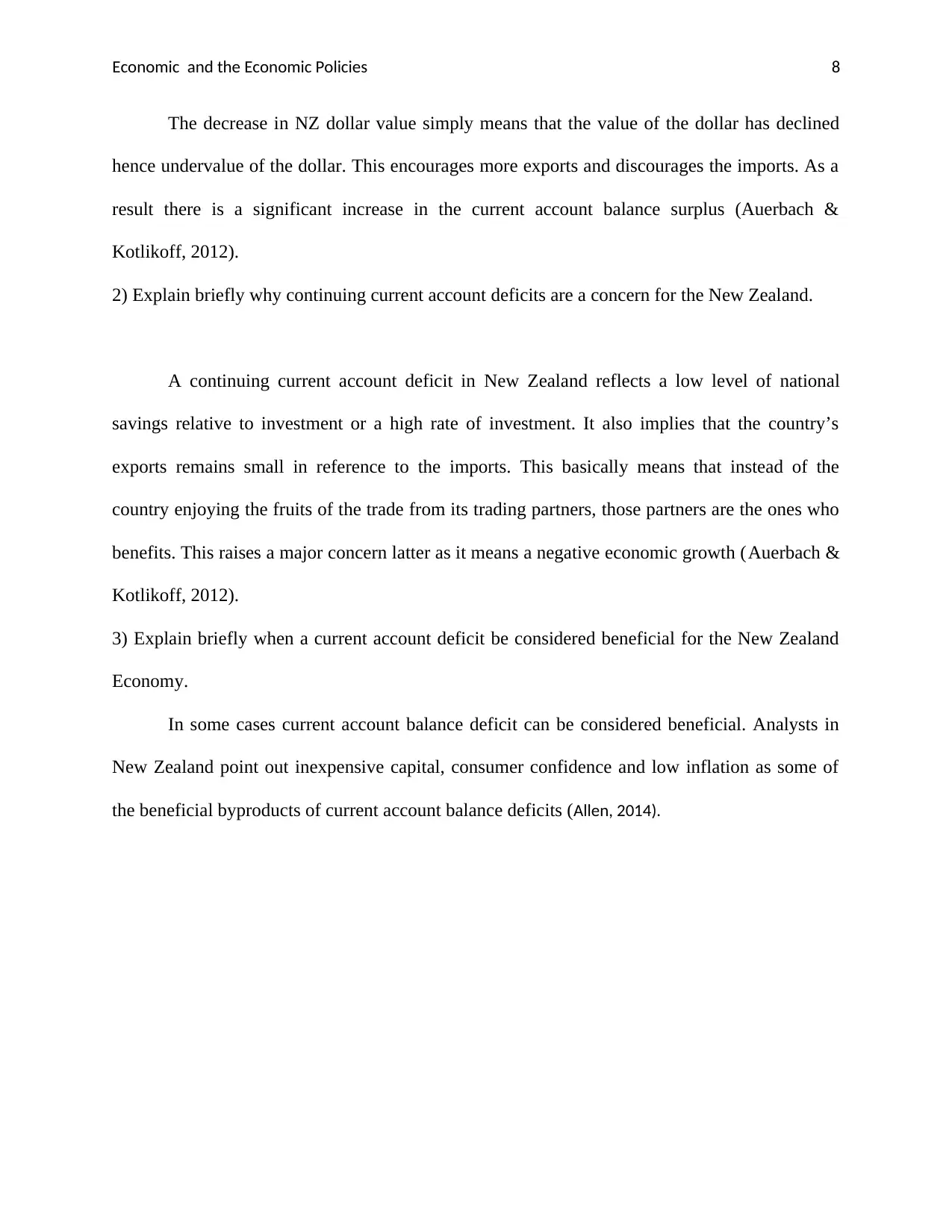
Economic and the Economic Policies 8
The decrease in NZ dollar value simply means that the value of the dollar has declined
hence undervalue of the dollar. This encourages more exports and discourages the imports. As a
result there is a significant increase in the current account balance surplus (Auerbach &
Kotlikoff, 2012).
2) Explain briefly why continuing current account deficits are a concern for the New Zealand.
A continuing current account deficit in New Zealand reflects a low level of national
savings relative to investment or a high rate of investment. It also implies that the country’s
exports remains small in reference to the imports. This basically means that instead of the
country enjoying the fruits of the trade from its trading partners, those partners are the ones who
benefits. This raises a major concern latter as it means a negative economic growth (Auerbach &
Kotlikoff, 2012).
3) Explain briefly when a current account deficit be considered beneficial for the New Zealand
Economy.
In some cases current account balance deficit can be considered beneficial. Analysts in
New Zealand point out inexpensive capital, consumer confidence and low inflation as some of
the beneficial byproducts of current account balance deficits (Allen, 2014).
The decrease in NZ dollar value simply means that the value of the dollar has declined
hence undervalue of the dollar. This encourages more exports and discourages the imports. As a
result there is a significant increase in the current account balance surplus (Auerbach &
Kotlikoff, 2012).
2) Explain briefly why continuing current account deficits are a concern for the New Zealand.
A continuing current account deficit in New Zealand reflects a low level of national
savings relative to investment or a high rate of investment. It also implies that the country’s
exports remains small in reference to the imports. This basically means that instead of the
country enjoying the fruits of the trade from its trading partners, those partners are the ones who
benefits. This raises a major concern latter as it means a negative economic growth (Auerbach &
Kotlikoff, 2012).
3) Explain briefly when a current account deficit be considered beneficial for the New Zealand
Economy.
In some cases current account balance deficit can be considered beneficial. Analysts in
New Zealand point out inexpensive capital, consumer confidence and low inflation as some of
the beneficial byproducts of current account balance deficits (Allen, 2014).
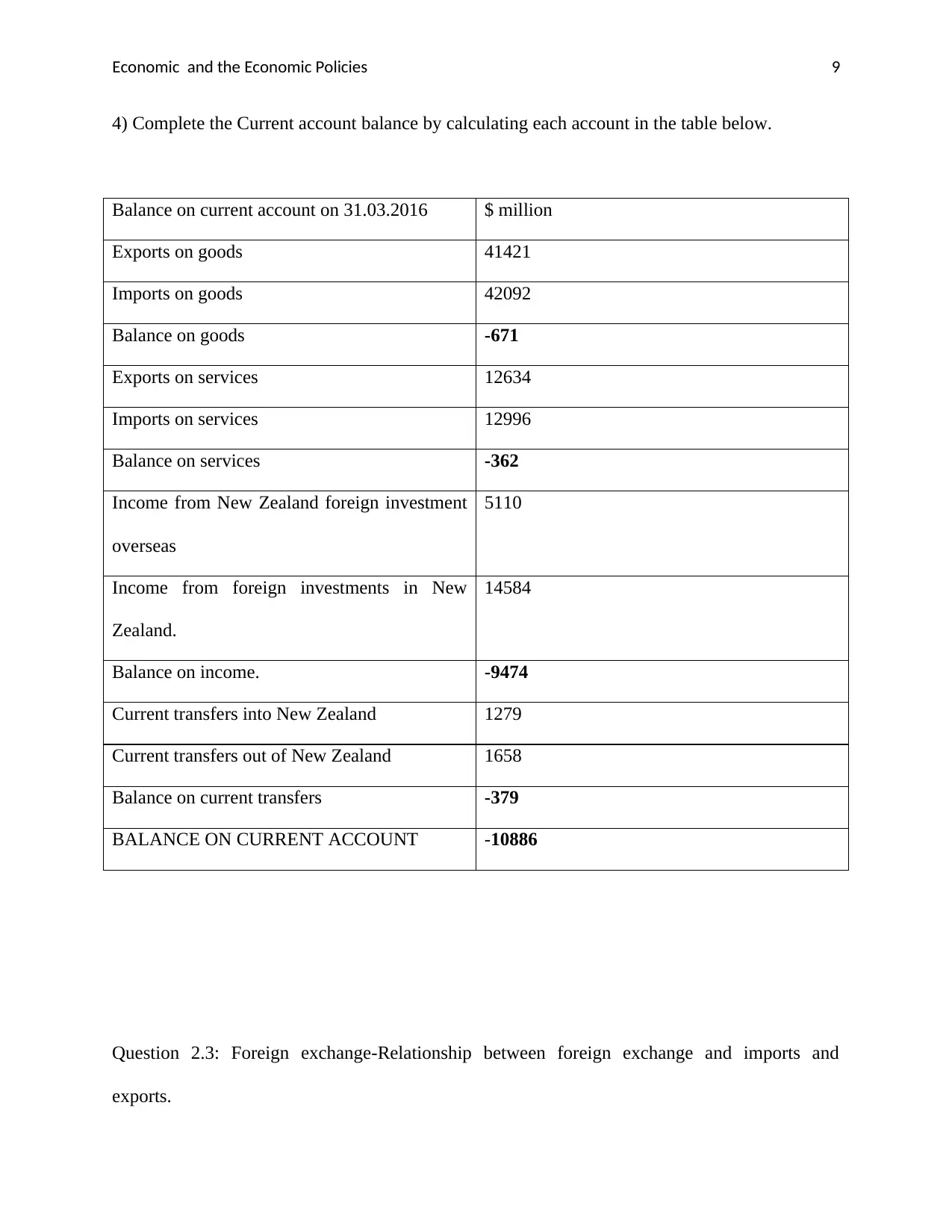
Economic and the Economic Policies 9
4) Complete the Current account balance by calculating each account in the table below.
Balance on current account on 31.03.2016 $ million
Exports on goods 41421
Imports on goods 42092
Balance on goods -671
Exports on services 12634
Imports on services 12996
Balance on services -362
Income from New Zealand foreign investment
overseas
5110
Income from foreign investments in New
Zealand.
14584
Balance on income. -9474
Current transfers into New Zealand 1279
Current transfers out of New Zealand 1658
Balance on current transfers -379
BALANCE ON CURRENT ACCOUNT -10886
Question 2.3: Foreign exchange-Relationship between foreign exchange and imports and
exports.
4) Complete the Current account balance by calculating each account in the table below.
Balance on current account on 31.03.2016 $ million
Exports on goods 41421
Imports on goods 42092
Balance on goods -671
Exports on services 12634
Imports on services 12996
Balance on services -362
Income from New Zealand foreign investment
overseas
5110
Income from foreign investments in New
Zealand.
14584
Balance on income. -9474
Current transfers into New Zealand 1279
Current transfers out of New Zealand 1658
Balance on current transfers -379
BALANCE ON CURRENT ACCOUNT -10886
Question 2.3: Foreign exchange-Relationship between foreign exchange and imports and
exports.
⊘ This is a preview!⊘
Do you want full access?
Subscribe today to unlock all pages.

Trusted by 1+ million students worldwide
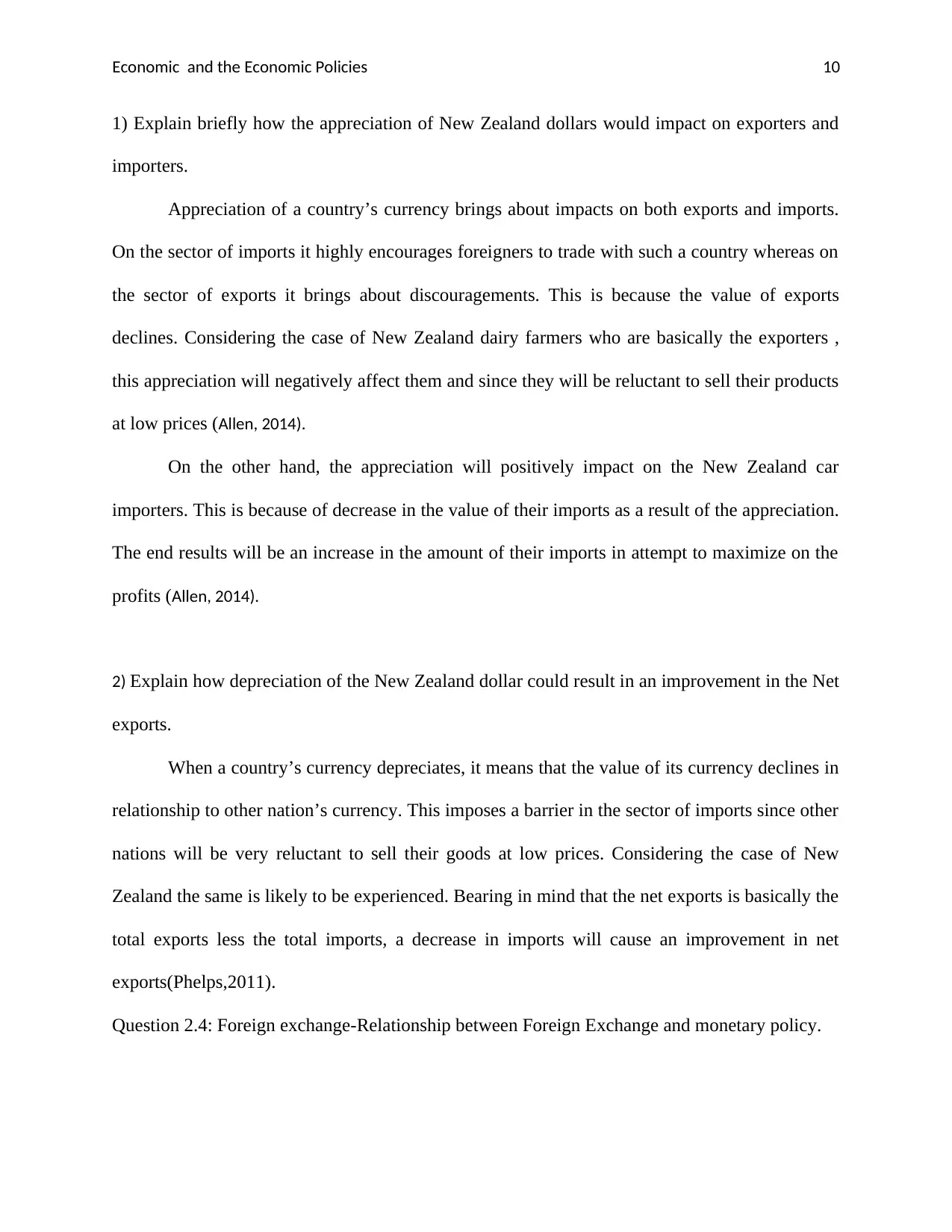
Economic and the Economic Policies 10
1) Explain briefly how the appreciation of New Zealand dollars would impact on exporters and
importers.
Appreciation of a country’s currency brings about impacts on both exports and imports.
On the sector of imports it highly encourages foreigners to trade with such a country whereas on
the sector of exports it brings about discouragements. This is because the value of exports
declines. Considering the case of New Zealand dairy farmers who are basically the exporters ,
this appreciation will negatively affect them and since they will be reluctant to sell their products
at low prices (Allen, 2014).
On the other hand, the appreciation will positively impact on the New Zealand car
importers. This is because of decrease in the value of their imports as a result of the appreciation.
The end results will be an increase in the amount of their imports in attempt to maximize on the
profits (Allen, 2014).
2) Explain how depreciation of the New Zealand dollar could result in an improvement in the Net
exports.
When a country’s currency depreciates, it means that the value of its currency declines in
relationship to other nation’s currency. This imposes a barrier in the sector of imports since other
nations will be very reluctant to sell their goods at low prices. Considering the case of New
Zealand the same is likely to be experienced. Bearing in mind that the net exports is basically the
total exports less the total imports, a decrease in imports will cause an improvement in net
exports(Phelps,2011).
Question 2.4: Foreign exchange-Relationship between Foreign Exchange and monetary policy.
1) Explain briefly how the appreciation of New Zealand dollars would impact on exporters and
importers.
Appreciation of a country’s currency brings about impacts on both exports and imports.
On the sector of imports it highly encourages foreigners to trade with such a country whereas on
the sector of exports it brings about discouragements. This is because the value of exports
declines. Considering the case of New Zealand dairy farmers who are basically the exporters ,
this appreciation will negatively affect them and since they will be reluctant to sell their products
at low prices (Allen, 2014).
On the other hand, the appreciation will positively impact on the New Zealand car
importers. This is because of decrease in the value of their imports as a result of the appreciation.
The end results will be an increase in the amount of their imports in attempt to maximize on the
profits (Allen, 2014).
2) Explain how depreciation of the New Zealand dollar could result in an improvement in the Net
exports.
When a country’s currency depreciates, it means that the value of its currency declines in
relationship to other nation’s currency. This imposes a barrier in the sector of imports since other
nations will be very reluctant to sell their goods at low prices. Considering the case of New
Zealand the same is likely to be experienced. Bearing in mind that the net exports is basically the
total exports less the total imports, a decrease in imports will cause an improvement in net
exports(Phelps,2011).
Question 2.4: Foreign exchange-Relationship between Foreign Exchange and monetary policy.
Paraphrase This Document
Need a fresh take? Get an instant paraphrase of this document with our AI Paraphraser
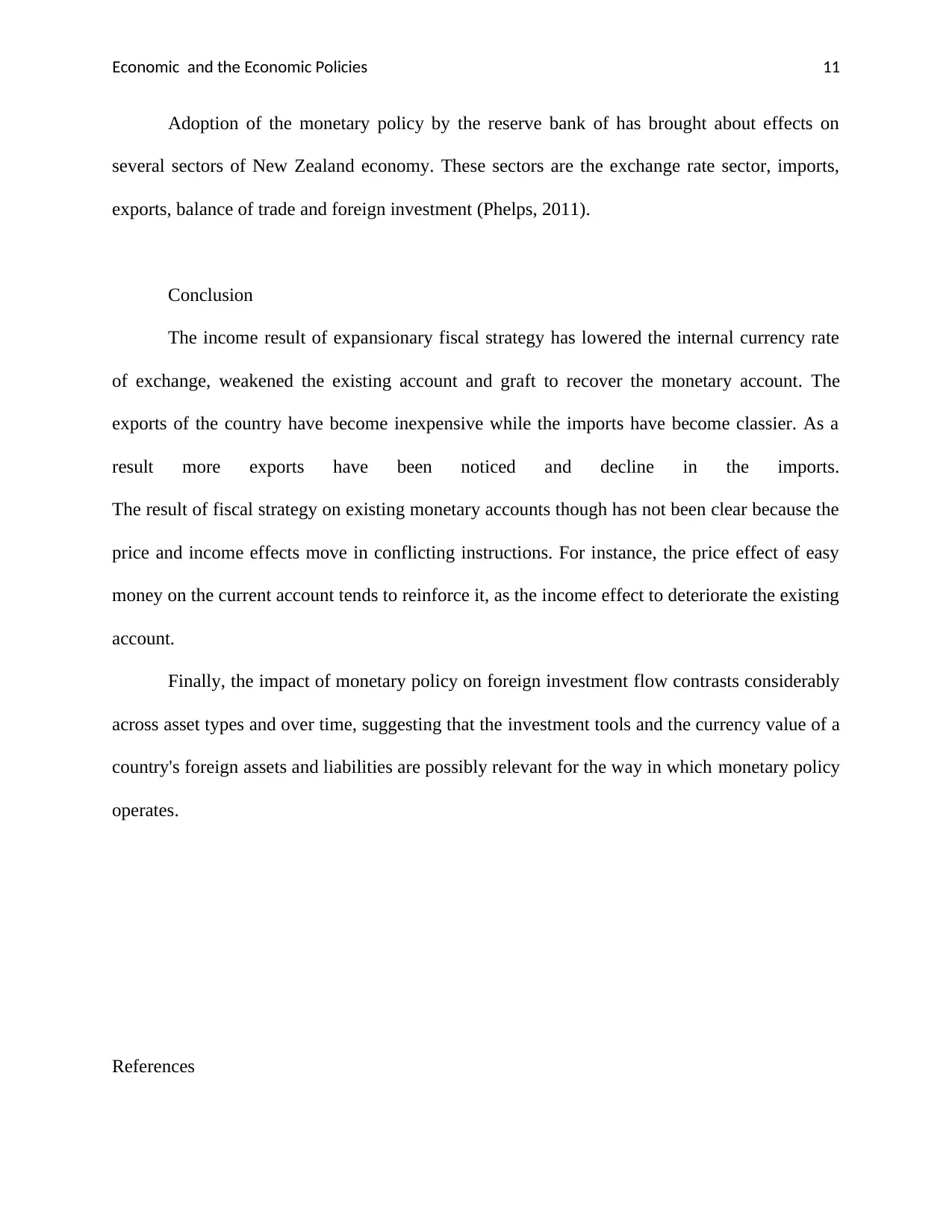
Economic and the Economic Policies 11
Adoption of the monetary policy by the reserve bank of has brought about effects on
several sectors of New Zealand economy. These sectors are the exchange rate sector, imports,
exports, balance of trade and foreign investment (Phelps, 2011).
Conclusion
The income result of expansionary fiscal strategy has lowered the internal currency rate
of exchange, weakened the existing account and graft to recover the monetary account. The
exports of the country have become inexpensive while the imports have become classier. As a
result more exports have been noticed and decline in the imports.
The result of fiscal strategy on existing monetary accounts though has not been clear because the
price and income effects move in conflicting instructions. For instance, the price effect of easy
money on the current account tends to reinforce it, as the income effect to deteriorate the existing
account.
Finally, the impact of monetary policy on foreign investment flow contrasts considerably
across asset types and over time, suggesting that the investment tools and the currency value of a
country's foreign assets and liabilities are possibly relevant for the way in which monetary policy
operates.
References
Adoption of the monetary policy by the reserve bank of has brought about effects on
several sectors of New Zealand economy. These sectors are the exchange rate sector, imports,
exports, balance of trade and foreign investment (Phelps, 2011).
Conclusion
The income result of expansionary fiscal strategy has lowered the internal currency rate
of exchange, weakened the existing account and graft to recover the monetary account. The
exports of the country have become inexpensive while the imports have become classier. As a
result more exports have been noticed and decline in the imports.
The result of fiscal strategy on existing monetary accounts though has not been clear because the
price and income effects move in conflicting instructions. For instance, the price effect of easy
money on the current account tends to reinforce it, as the income effect to deteriorate the existing
account.
Finally, the impact of monetary policy on foreign investment flow contrasts considerably
across asset types and over time, suggesting that the investment tools and the currency value of a
country's foreign assets and liabilities are possibly relevant for the way in which monetary policy
operates.
References
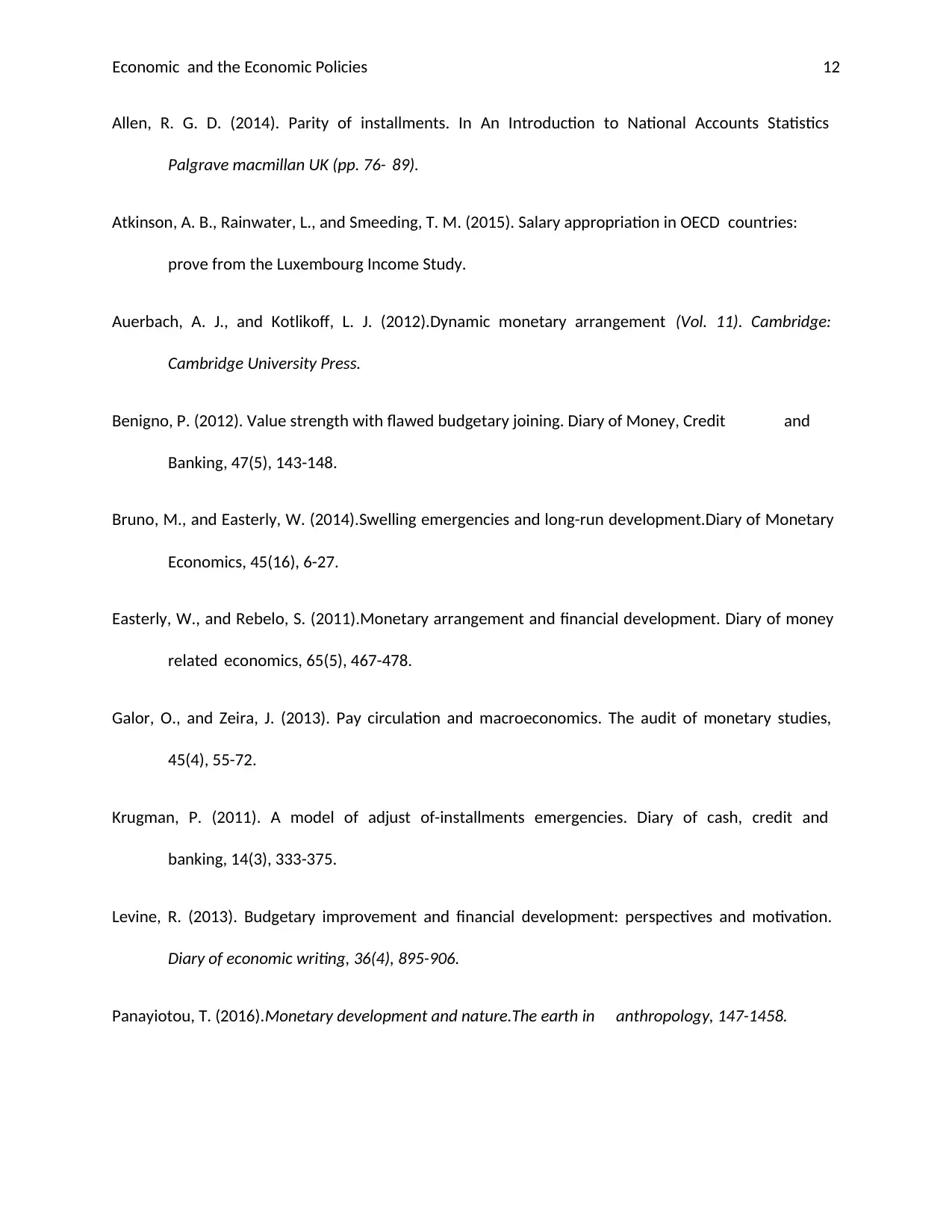
Economic and the Economic Policies 12
Allen, R. G. D. (2014). Parity of installments. In An Introduction to National Accounts Statistics
Palgrave macmillan UK (pp. 76- 89).
Atkinson, A. B., Rainwater, L., and Smeeding, T. M. (2015). Salary appropriation in OECD countries:
prove from the Luxembourg Income Study.
Auerbach, A. J., and Kotlikoff, L. J. (2012).Dynamic monetary arrangement (Vol. 11). Cambridge:
Cambridge University Press.
Benigno, P. (2012). Value strength with flawed budgetary joining. Diary of Money, Credit and
Banking, 47(5), 143-148.
Bruno, M., and Easterly, W. (2014).Swelling emergencies and long-run development.Diary of Monetary
Economics, 45(16), 6-27.
Easterly, W., and Rebelo, S. (2011).Monetary arrangement and financial development. Diary of money
related economics, 65(5), 467-478.
Galor, O., and Zeira, J. (2013). Pay circulation and macroeconomics. The audit of monetary studies,
45(4), 55-72.
Krugman, P. (2011). A model of adjust of-installments emergencies. Diary of cash, credit and
banking, 14(3), 333-375.
Levine, R. (2013). Budgetary improvement and financial development: perspectives and motivation.
Diary of economic writing, 36(4), 895-906.
Panayiotou, T. (2016).Monetary development and nature.The earth in anthropology, 147-1458.
Allen, R. G. D. (2014). Parity of installments. In An Introduction to National Accounts Statistics
Palgrave macmillan UK (pp. 76- 89).
Atkinson, A. B., Rainwater, L., and Smeeding, T. M. (2015). Salary appropriation in OECD countries:
prove from the Luxembourg Income Study.
Auerbach, A. J., and Kotlikoff, L. J. (2012).Dynamic monetary arrangement (Vol. 11). Cambridge:
Cambridge University Press.
Benigno, P. (2012). Value strength with flawed budgetary joining. Diary of Money, Credit and
Banking, 47(5), 143-148.
Bruno, M., and Easterly, W. (2014).Swelling emergencies and long-run development.Diary of Monetary
Economics, 45(16), 6-27.
Easterly, W., and Rebelo, S. (2011).Monetary arrangement and financial development. Diary of money
related economics, 65(5), 467-478.
Galor, O., and Zeira, J. (2013). Pay circulation and macroeconomics. The audit of monetary studies,
45(4), 55-72.
Krugman, P. (2011). A model of adjust of-installments emergencies. Diary of cash, credit and
banking, 14(3), 333-375.
Levine, R. (2013). Budgetary improvement and financial development: perspectives and motivation.
Diary of economic writing, 36(4), 895-906.
Panayiotou, T. (2016).Monetary development and nature.The earth in anthropology, 147-1458.
⊘ This is a preview!⊘
Do you want full access?
Subscribe today to unlock all pages.

Trusted by 1+ million students worldwide
1 out of 12
Related Documents
Your All-in-One AI-Powered Toolkit for Academic Success.
+13062052269
info@desklib.com
Available 24*7 on WhatsApp / Email
![[object Object]](/_next/static/media/star-bottom.7253800d.svg)
Unlock your academic potential
Copyright © 2020–2025 A2Z Services. All Rights Reserved. Developed and managed by ZUCOL.





